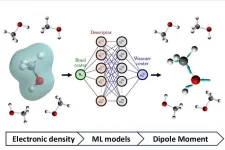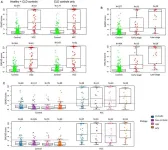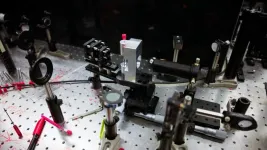(Press-News.org) A passage in the Norse Sverris Saga, the 800-year-old story of King Sverre Sigurdsson, describes a military raid that occurred in AD 1197, during which a body was thrown into a well at Sverresborg Castle, outside Trondheim in central Norway, likely as an attempt to poison the main water source for the local inhabitants. A new study published in the Cell Press journal iScience on October 25 describes how researchers used ancient DNA to corroborate the events of the saga and discover details about the “Well-man,” blending history and archaeology with science and setting a precedent for future research on historical figures.
“This is the first time that a person described in these historical texts has actually been found,” says Professor Michael D. Martin of the Norwegian University of Science and Technology’s University Museum in Trondheim, Norway. “There are a lot of these medieval and ancient remains all around Europe, and they’re increasingly being studied using genomic methods.”
In 1938, bones were found in the well at Sverresborg Castle, but researchers at the time lacked the tools to do much aside from visual analysis. Now, radiocarbon dating and advanced gene-sequencing technology have allowed researchers to craft a more intricate picture of who the Well-man was. Radiocarbon dating confirmed that the body is approximately 900 years old, and studies conducted in 2014 and 2016 confirmed that the body belonged to a male who was between 30 and 40 years old at the time of death.
“The text is not absolutely correct—what we have seen is that the reality is much more complex than the text,” says archaeologist Anna Petersén of the Norwegian Institute of Cultural Heritage Research in Oslo, Norway.
“We can corroborate what actually happened in a more neutral way,” says Dr. Martin Rene Ellegaard of the Norwegian University of Science and Technology. As part of his work toward a doctoral degree, Ellegaard used samples of a tooth obtained from the Well-man’s skeleton to sequence his genome. Using this information, the team was able to ascertain that he most likely had blue eyes and blond or light-brown hair, and his ancestors likely hailed from the southernmost Norwegian county of present-day Vest-Agder.
The researchers were able to draw conclusions about the Well-man’s ancestry thanks to a large amount of reference data from the genomes of modern-day Norwegians made available through a collaboration with Professor Agnar Helgason at deCODE Genetics in Iceland. “Most of the work that we do is reliant on having reference data,” says Ellegaard. “So the more ancient genomes that we sequence and the more modern individuals that we sequence, the better the analysis will be in the future.”
“Those reference data are literally thousands of genomes of modern Norwegians and many thousands of other European genomes,” says Martin.
However, this technology has its limitations, as sampling the Well-man’s genome required removing the outer surface from his tooth—to avoid contamination from those who had handled it in non-sterile environments, such as during excavation—and grinding the tooth into a powder. This means that the sample can no longer be used for further tests, and researchers were not able to get data on any pathogens the Well-man may have been carrying at his time of death.
“It was a compromise between removing surface contamination of the people who have touched the tooth and then removing some of the possible pathogens … there are lots of ethical considerations,” says Ellegaard. “We need to consider what kind of tests we’re doing now because it will limit what we can do in the future.”
The researchers say that they would like to test samples from other historical figures. “The important Norwegian Saint Olaf is thought to be buried somewhere in Trondheim Cathedral,” says Martin, “so I think that if eventually his remains are uncovered, there could be some effort to describe him physically and trace his ancestry using genetic sequencing.”
Speaking to this new technique of blending of history and science, Petersén concludes, “It’s a fantastic result on what Ellegaard and Martin’s method can bring to archaeology in such a strange or rare context like this is.”
###
This work was supported by the NTNU Onsager Fellowship, the Norwegian Research Council, the Carlsbergfondet Semper Ardens grant, and the Norwegian Institute of Cultural Research.
iScience, Ellegaard et al.: “Corroborating written history with ancient DNA: the case of the Well-man described in an Old Norse saga” https://www.cell.com/iscience/fulltext/S2589-0042(24)02301-0
iScience (@iScience_CP) is an open access journal from Cell Press that provides a platform for original research and interdisciplinary thinking in the life, physical, and earth sciences. The primary criterion for publication in iScience is a significant contribution to a relevant field combined with robust results and underlying methodology. Visit https://www.cell.com/iscience. To receive Cell Press media alerts, contact press@cell.com.
END
About The Study: This overview identifies research gaps and methodological challenges that need to be addressed to guide intervention strategies and future policy relevant to youth and suicide risk.
Corresponding Author: To contact the corresponding author, Lisa H. Jaycox, PhD, email lisa.jaycox@nimh.gov.
To access the embargoed study: Visit our For The Media website at this link https://media.jamanetwork.com/
(doi:10.1001/jamanetworkopen.2024.41499)
Editor’s Note: Please see ...
About The Study: This cohort study found that postacute infection syndrome is not unique to COVID-19; it can also occur in people with other severe lower respiratory tract infections (LRTIs). However, compared with other LRTIs, COVID-19 appeared to impose an extra burden of neurological, cognitive, and fatigue symptoms. These findings highlight the similarities and differences between post–COVID-19 condition and postacute infection syndrome triggered by other pathogens, which will inform tailored clinical management and offer mechanistic insights into these previously overlooked syndromes.
Corresponding Author: To contact the corresponding author, Junqing Xie, ...
About The Study: This cross-sectional study of privately insured patients found a more than 2-fold increase in use of glucagon-like peptide-1 receptor agonists (GLP-1 RAs) as anti-obesity medications from 2022 to 2023, with a 25.6% decrease in the rate of metabolic bariatric surgery during the same period. Our results provide a national contemporaneous estimate of the decline in metabolic bariatric surgery associated with the era of GLP-1 RAs.
Corresponding Author: To contact the corresponding author, Thomas C. Tsai, ...
Cardiovascular disease remains a top cause of sickness and death in the U.S. and worldwide. Doctors and researchers have it especially high on their radar because it’s more modifiable and preventable than many other diseases and causes of death.
Importantly, though, modification and prevention rely on early detection and mitigation of risk factors like hypertension and high cholesterol. Unfortunately, detection and mitigation are suboptimal throughout the U.S. population: Experts estimate that up to 75% of young adults who have risk factors such as hypertension and high cholesterol are unaware ...
Researchers Tomohito Amano and Shinji Tsuneyuki of the University of Tokyo with Tamio Yamazaki of CURIE (JSR-UTokyo Collaboration Hub) have developed a new machine learning model to predict the dielectric function of materials, rather than calculating from first-principles. The dielectric function measures the polarization of negative and positive charges within materials, the phenomenon underlying dielectric materials. Thus, the fast and accurate prediction of dielectric function facilitates the development of novel dielectric materials, an ingredient of many cutting-edge technologies such as 6G ...
The information environment in Finland during the coronavirus pandemic was exceptional and intense in many ways. The spread of disinformation and the number of actors involved reached unprecedented levels. The demand for accurate information was enormous, and the situation was constantly evolving. Information was disseminated through various channels. Official information played a crucial role, but at the same time, social media posed challenges in the fight against false and misleading information.
Malicious bots increased significantly during the pandemic. The operation of bots – i.e. ...
Background and objectives
Depression can lead to poor outcomes during antiretroviral therapy, and current evidence suggests high rates of depression among people living with human immunodeficiency virus (PLHIV), especially in low-and middle-income countries. This study was designed to investigate the sociodemographic factors associated with depression among PLHIV on antiretroviral therapy in a Nigerian cosmopolitan city.
Methods
A hospital-based, cross-sectional study was conducted among 592 consenting, ...
Background and Aims
Early detection of hepatocellular carcinoma (HCC) is crucial for improving survival in patients with chronic hepatitis. The GALAD algorithm combines gender (biological sex), age, α-fetoprotein (AFP), Lens culinaris agglutinin-reactive fraction of AFP (AFP-L3), and protein induced by vitamin K absence or antagonist-II (PIVKA-II) for HCC detection. Similarly, the GAAD algorithm incorporates gender (biological sex), age, AFP, and PIVKA-II. This study aimed to assess the clinical utility of AFP-L3 in the GALAD algorithm and its potential synergies with ultrasound. We compared the clinical performance of GALAD with GAAD; AFP; AFP-L3; and PIVKA-II, with ...
Background and Aims
Data regarding risk factors and long-term outcomes of U.S. patients with biopsy-proven metabolic dysfunction-associated steatotic liver disease (MASLD) are limited. This study aimed to investigate the role of clinical and histologic risk factors on long-term outcomes in patients with MASLD.
Methods
A retrospective cohort study of 451 adults with biopsy-proven MASLD was conducted at a U.S. academic hospital from 2012 to 2020. An experienced pathologist evaluated the index liver biopsy. Patients with a prior liver transplant or alternative etiologies of chronic liver disease were excluded. The duration ...
Water is synonymous with life, but the dynamic, multifaceted interaction that brings H2O molecules together – the hydrogen bond – remains mysterious. Hydrogen bonds result when hydrogen and oxygen atoms between water molecules interact, sharing electronic charge in the process. This charge-sharing is a key feature of the three-dimensional ‘H-bond’ network that gives liquid water its unique properties, but quantum phenomena at the heart of such networks have thus far been understood only through theoretical simulations.
Now, researchers led by Sylvie Roke, head of the Laboratory for Fundamental BioPhotonics in EPFL’s School of Engineering, ...



